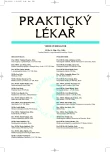Hantaviruses and related diseases in the Czech Republic
Hantaviry a jimi vyvolávaná onemocnění v České republice
Hantaviry vyvolávají v Eurasii onemocnění nazývané hemorragická horečka s ledvinovým syndromem. Přestože toto onemocnění je známé již velmi dlouho, jeho původci byli popsáni až teprve v roce 1978 v Koreji. V roce 1993 byl popsán v USA hantavirový plicní syndrom, který vyvolává jiná skupina hantavirů. V Evropě cirkulují tři genospecies: Puumala, Dobrava-Belgrade a Tula. Hantaviry se reprodukují ve specifických hostitelích z řad hlodavců v přírodních ohniscích. Člověk se nakazí při vniknutí do ohniska kontaminovaným aerosolem. Práce popisuje vlastnosti hantavirů, klinické příznaky onemocnění, jeho patogenezi a epidemiologii s důrazem na situaci v České republice.
Klíčová slova:
Hantavirus, Puumala, Dobrava-Belgrade, Tula, hemorragická horečka s renálním syndro¬mem, nephropathia epidemica
Authors:
Pejčoch M.' 1 2; B. Kříž 1
Authors‘ workplace:
Státní zdravotní ústav v Praze
; Ředitel: MUDr. Jaroslav Volf, PhD.
Zdravotní ústav se sídlem v Brně
Ředitel: RNDr. Bohumil Pokorný, CSc.
2
Published in:
Prakt. Lék. 2007; 87(9): 545-549
Category:
Of different specialties
Overview
Haemorrhagic fever with renal syndrome is the infectious disease caused in Eurasia by Hantaviruses. This disease was known for a long time. Despite this fact the cause of it was described in Korea only in 1978. Hantaviral pulmonary syndrome caused by different group of Hantaviruses has been described in USA in 1993. Three genospecies circulate: Puumala, Dobrava-Belgrade a Tula in Europe. Hantaviruses are reproducing in particular kinds of rodents in their natural habitants. Humans are infected by entering in their areas contaminated by aerosols. This article describes the characteristics of Hantaviruses, clinical appearance of the human disease, its pathogenesis and epidemiology with accent on the situation in the Czech Republic.
Key words:
Hantaviruses, Puumala, Dobrava-Belgrade, Tula, haemorrhagic fever with renal syndrome, nephropathia epidemica.
Labels
General practitioner for children and adolescents General practitioner for adultsArticle was published in
General Practitioner

2007 Issue 9
- Hope Awakens with Early Diagnosis of Parkinson's Disease Based on Skin Odor
- Memantine Eases Daily Life for Patients and Caregivers
- Metamizole vs. Tramadol in Postoperative Analgesia
- Metamizole at a Glance and in Practice – Effective Non-Opioid Analgesic for All Ages
- Advances in the Treatment of Myasthenia Gravis on the Horizon
Most read in this issue
- Hypotermia as an injury, illness, symptom
- Induratio penis plastica – diagnostics and treatment
- Calcium score assessment combined with myocardial perfusion stress test by single photon tomography (SPECT). Two case studies.
- Hantaviruses and related diseases in the Czech Republic
